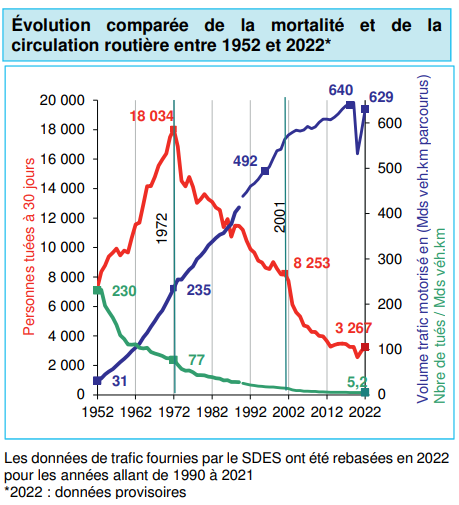From the post-war period to the present day, around 700,000 people have been killed on French roads.
The improvement of road safety results from action taken on three fundamental and inseparable levers:
- infrastructure; design, maintenance and operation;
- vehicle through passive and active safety
- road user behaviour, through education, prevention and enforcement.
Better post-crash care for the wounded and medical progress complete the system.
From after the war to 1972
Accident rates soared after the Second World War with the expansion of the car fleet. All traffic regulations were clarified in 1954, and the accident data collection system was made more reliable, recording 7,166 people killed at 3 days (killed on the spot or in the 3 days following the accident). Investment in national roads (RN) has made travel faster and safer: half of all motorways were built between 1946 and 1975, treatement of blackheads on RN began in the 1960s; in 1962, the maximum authorised speed (VMA) was 60 km/h in towns and cities and, at the end of the decade, experiments were carried out with speed limits on main roads at weekends when there were major on motorways at the end of the decade. Blood alcohol limits were introduced (fines 0,8 g/L, offences 1,2 g/L blood alcohol). Over the period 1952-1972, the number of deaths multiplied by 2,5 and traffic by 7,5: the number of people killed per billion veh.km travelled fell from 230 to 77.
Compared development of traffic and fatalities on French roads from 1952 to 2022

From 1972 to 2002
Road safety policy gets organised: creation of the Interministerial Road Safety Committee, appointment of an interministerial delegate. In 1972, the 16,545 deaths in 6 days (or 18,000 deaths in 30 days), a situation denounced by the 16,000 residents of Mazamet, who were lying on the ground. This collective awareness led to the introduction of VMAs outside towns and cities, and the wearing of seatbelts in cars. Seatbelts to be worn at the front (in 1991 at the rear) and gradually helmets for 2WDs. Local road safety policy is becoming more structured (departmental road safety plans); the REAGIR1 programme was set up after the Beaune accident in 1982 (53 deaths, including 44 children). Vehicles are safer (anti-lock brakes and airbags, roadworthiness tests in 1985). In 1989, the White Paper on road safety set out the main guidelines and expressed the need to improve controls. The points-based
points driving licence was introduced in 1992. The number of deaths fell by - 27% over 1972-1982 (traffic multiplied by 1.4), by - 24% over 1982-1992 (traffic multiplied by 1.3), and
- 22% over 1992-2002 (traffic multiplied by 1.2). In 2002, there were 14 fatalities per billion veh.km travelled.
From 2002 to 2022
The National Road Safety Council (CNSR) was created in 2001. In July 2002, road safety was one of the President's four priorities, of the French Republic. The first fixed speed cameras were speed cameras were installed. The probationary licence was introduced in 2004. Driving under the influence of alcohol led to the deduction of 6 points. Fewer than 5,000 deaths in 2006 and a 51% reduction in the death rate deaths between 2000 and 2010. More than 30 000 lives have been saved during this period, three quarters of which were thanks to lower speeds and 11% thanks to improved improvements in vehicle safety. With a target of a 50% reduction in deaths by 2000-2010, the European Union is taking up the target for 2010-2020. But road mortality in France, like in other European countries, slowed down after 2013. Despite new measures (commitments by employers diversified speed cameras, effective alcohol and drug testing, access to 2WDs, lowering of the speed limit to 80 kph), the trend slowed at the end of the decade, but without achieving the target. Traffic restrictions during the pandemic in 2020 and 2021 will occasionally reduce the number of road mortality ( in 2020 result equivalent to 1925 for a fleet multiplied by 50 ), but 2022 saw a return to the level of 2019. Fatalities fell by 53% between 2002 and 2012 (traffic multiplied by 1,1), and by -11% over 2012-2019 (traffic virtually unchanged). The number of people killed per billion veh.km travelled down from 14 to 5.
2030 Outlook
France supports the European objective of dividing by two the number of killed and seriously injured by 2030 (taking 2019 as the reference year, before the pandemic). The proportion of older people in the population contributing to road deaths will continue to rise. Post-pandemic, if the situation in 2022 is equivalent to 2019, the mortality structure has with the development of soft modes of transport telecommuting, etc. In addition, Europe is making the development of mobility as part of a "Fit for 55" decarbonisation strategy (reducing CO2 emissions by 55% between 1990 and 2030). In France3, 30% of CO2 emissions are generated by transport. For individual journeys, the car accounts for 78% of emissions and the plane for 19%. The levers action are related to sobriety (reducing rather than increasing journeys, modal shift, car-sharing) and technological progress (clean vehicles and low-carbon energy production), and low-carbon energy production). The structure of the vehicle fleet will evolve (more electric, smaller vehicles), and mobility habits will be transformed in the medium term.

